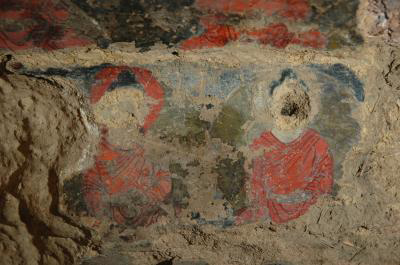Earliest Oil Paintings Discovered

Oil paintings have been found in caves behind the two ancient colossal Buddha statues destroyed in 2001 by the Taliban, suggesting that Asians — not Europeans — were the first to invent oil painting.
Many people worldwide were in shock when the Taliban destroyed the Buddha statues in the Afghan region of Bamiyan.
Behind those statues are caves decorated with paintings from the fifth to ninth centuries.
New experiments performed at the European Synchrotron Radiation Facility (ESRF) show that the paintings were made of oil, hundreds of years before the technique emerged in Europe. The results are detailed in the peer-reviewed Journal of Analytical Atomic Spectrometry.
“This is the earliest clear example of oil paintings in the world, although drying oils were already used by ancient Romans and Egyptians, but only as medicines and cosmetics," said researcher Yoko Taniguchi.
In many European history and art textbooks, oil painting is said to have started in the 15th century in Europe.
However, scientists from the National Research Institute for Cultural Properties in Tokyo (Japan), the Centre of Research and Restoration of the French Museums-CNRS (France), the Getty Conservation Institute (United States) and the ESRF have recently identified drying oils in some samples studied from the Bamiyan caves.
Sign up for the Live Science daily newsletter now
Get the world’s most fascinating discoveries delivered straight to your inbox.
Painted in the mid-seventh century, the murals show scenes with Buddhas in vermilion robes sitting cross-legged amid palm leaves and mythical creatures. The scientists discovered that 12 out of the 50 caves were painted with oil painting techniques, using perhaps walnut and poppy seed drying oils.
The researchers relied on a combination of synchrotron techniques, including infrared micro-spectroscopy, micro X-ray fluorescence, micro X-ray absorption spectroscopy and micro X-ray diffraction.
"On one hand, the paintings are arranged as superposition of multiple layers, which can be very thin," said Marine Cotte, a research scientist at CNRS and an ESRF scientific collaborator. "The micrometric beam provided by synchrotron sources was hence essential to analyze separately each of these layers. On the other hand, these paintings are made with inorganic pigments mixed in organic binders, so we needed different techniques to get the full picture."
The results showed a high diversity of pigments as well as binders, and the scientists identified original ingredients and alteration compounds. Apart from oil-based paint layers, some of the layers were made of natural resins, proteins, gums, and, in some cases, a resinous, varnish-like layer.
Protein-based material can indicate the use of hide glue or egg. Within the various pigments, the scientists found a high use of lead whites. These lead carbonates are often used paintings.
The paintings are probably the work of artists who traveled on the Silk Road, the ancient trade route between China, across Central Asia's desert to the West. However, there are very few studies about this region.
"Due to political reasons, research on paintings in Central Asia is scarce. We were fortunate to get the opportunity from UNESCO, as a part of conservation project for the World Heritage site Bamiyan, to study these samples, and we hope that future research may provide deeper understanding of the painting techniques along the Silk Road and the Eurasian area”, Taniguchi said.
The results, publicly announced today, previously were presented in a scientific conference in Japan in January. The research was funded by the ESRF, the Ministry of Information and Culture of Afghanistan and UNESCO. A part of this study was also funded by the Grant-in-Aid for Scientific Research, Grant-in-Aid for Young Scientists from the Ministry of Education and Culture, Sports, Science and Technology of Japan.
- History's Most Overlooked Mysteries
- Gallery: Amazing Egyptian Discoveries
- Quiz: The Artifact Wars











